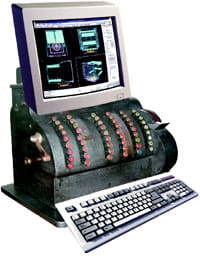Pushing Paper Aside
Despite the long-acknowledged advantages of electronic processing of invoices and payments, companies have been slow to let go of paper. The Web is changing all that.

For the past 20 years, technology vendors have tempted companies with the promise of the paperless office. Most companies strived to achieve this paperless nirvana using EDI (Electronic Data Interchange) to exchange trade documentation such as invoices electronically. But for most companies [EDI was] cost-prohibitive and difficult to implement, notes Elizabeth Robertson, an analyst with TowerGroup. And while it may have worked with one or two suppliers, for most companies it was difficult to extend the benefits of EDI to the whole supply chain.
The advent of the Internet changed that, promising ubiquitous connectivity and a more cost effective alternative for companies that could not afford the upfront investment in EDI. Electronic bill presentment and payment (EBPP), in which consumers visited a single website or individual sites to pay bills, was one of the earliest examples of how the Web could be used to eliminate the costs and inefficiencies associated with processing paper. According to a joint survey conducted by electronic payments association NACHA and TowerGroup, from 1996 to 2001 the number of consumer bill payments initiated online quadrupled from 113 million payments valued at $26.9 billion to more than 400 million bill payments worth $120.9 billion.
Although Web-based services such as electronic invoice presentment and payment (EIPP) demonstrated promise in automating the order-to-pay process, B2B presented more challenges than the consumer world. [The EIPP market] has been relatively slow to take off, due to both the complexity of implementing change in the B2B transaction environment and the prevalence of products oriented to biller/suppliers, explains TowerGroups Robertson.
TowerGroups research indicates that less than 1% of the 15.3 billion invoices issued annually in the US and the 12.2 billion invoices issued in the EU are generated electronically. In the consumer world, the relationship between biller/supplier and payer is less complex; B2B e-commerce encompasses more sophisticated business processes including procurement, fulfillment, financing, order matching, payment authorization and accounting.
As these captive companies have retained more risk, they have become a natural focus for corporate risk management, according to Clark. The advantages of captives were historically largely tax related, he says, but in recent years they have become a mechanism for efficient risk management.
|
Overnight Converts |
|
A Citigroup-sponsored online working capital survey conducted in September 2003 found that 49% of companies reported that less than 25% of their revenues were processed electronically. Only 8% received between 51% and 75% of their account receivables electronically. There are various challenges depending on the type of organization looking to deploy EIPP, says Dyfan Williams, commercial director, Accountis, a UK-based provider of payment and financial document solutions. If they are a large company, they are more likely to have the resources to put behind it. Williams says the challenge for smaller companies is that they may not have the purchasing power to convince suppliers to send invoices electronically, whereas larger companies can say, If you want to do business with me, you have got to send me invoices in this format, he explains. Until recently, most EIPP solutions were geared toward the supplier or biller. However, billers have not always been successful in generating interest among their full trading partners network, in part because payers want to govern the choice of a solution, says Robertson of TowerGroup. Alain Falys, CEO of Open Business Exchange (OBE), operators of OB10, a worldwide electronic invoicing network, believes that supplier-centric solutions do not work in the EIPP space. You need the sponsorship of the buyers, he says. OB10, which has more than 8,000 subscribers to its network, attracts suppliers by promising them that they will be able to send invoices electronically to many buyers. The traditional way of doing electronic invoicing was EDI, which was a one-to-one connection, Falys explains. The OB10 network is many-to-many, so suppliers can link to many buyers through a single connection. US-based TradeCard, a financial supply chain automation company that links buyers and sellers, grew its network by initially focusing on vertical industry sectors such as footwear and apparel. Once we got critical mass, adoption became easier because buyers were saying to their suppliers they wanted to do this, says Kurt Cavano, TradeCards CEO. |
Critical Mass
Cavano says the companies that get the most value from its platform have 80% of their suppliers on board. It doesnt make sense to do it with one vendor unless they are your main supplier. So once you get critical mass, you start to reap the benefits, he says.
The US currently leads Europe in terms of adoption of EIPP solutions. But a convergence of factors is expected to drive wider adoption on both sides of the Atlantic. The EU Electronic Invoicing Directive, implemented in January 2004, paved the way for EU member states to ascribe the same legal status to electronic invoices as paper invoices provided that authenticity of origin and content integrity could be guaranteed.
While the directive is expected to remove some of the barriers, Williams of Accountis believes most companies are still two to three years away from full-scale adoption of EIPP. However, he anticipates that additional regulatory imperatives such as Sarbanes-Oxley will add further impetus. With Sarbanes-Oxley, companies need to ensure that the systems behind financial information are valid and reliable, he says. EIPP solutions are also becoming more sophisticated, easing the pain for many companies that found previous technologies disruptive. Platforms such as OB10 and TradeCard can be accessed via a Web browser, and invoices can be filled in online. For more sophisticated companies, the EIPP vendor can interface with ERP or accounting systems. Accountiss electronic business printer allows companies to send invoices directly from their accounting systems. Accountis and OB10 also act as translation engines, converting the invoice issued by the supplier into a format accepted by the buyer, which Williams says is one of the biggest challenges around EIPP.
By automating the process, companies can eliminate the costsanywhere from 2 to 30 ($3.70-$56)of processing paper invoices. Receiving paper invoices and processing them is slow, says OBEs Falys, adding that by using its network, invoices can be received within hours as opposed to days. As the invoice is issued more quickly, suppliers can also expect to be paid sooner. One of the single biggest factors for adoption of EIPP by customers is the ability for suppliers to get paid earlier, Falys continues.
|
Order-to-pay |
||||
Networks like OB10 largely focus on electronic presentment of the invoice. Yet an increasing number of providers are linking the invoice to the payment to provide a complete end-to-end purchase-to-pay solution. TowerGroups Robertson believes an increasing number of payer-focused alternatives will ensure the continued expansion of Web-based EIP. The benefits of linking the invoice to accounts payable systems include substantial reductions in invoice, payment processing and dispute handling costs, as well as reduced supplier inquiries regarding invoice or payment status. If you are doing remittance electronically and the payment, it makes sense to do the invoice electronically, says Williams of Accountis.
JPMorgans hosted Order-To-Pay Service powered by B2B commerce provider Xign purports to reduce payment times to suppliers and enhance working capital. Card companies such as MasterCard are also getting in on the act, linking corporate purchasing cards to EIPP platforms. TradeCard claims to take EIPP a step further by linking together all stages of the order-to-pay process. Companies such as Burton Snowboards uses TradeCard to electronically route, manage and store trade documentation including purchase orders and payment information. As Burtons company treasurer Tom DUrso explains, the benefits extend beyond the obvious processing efficiencies of automating trade documents. I use TradeCards corporate-wide view of procurement data to forecast working capital requirements, he says. Now I can keep less cash on hand, and I have the right foreign currency at the right time to pay suppliers. |
Anita Hawser





